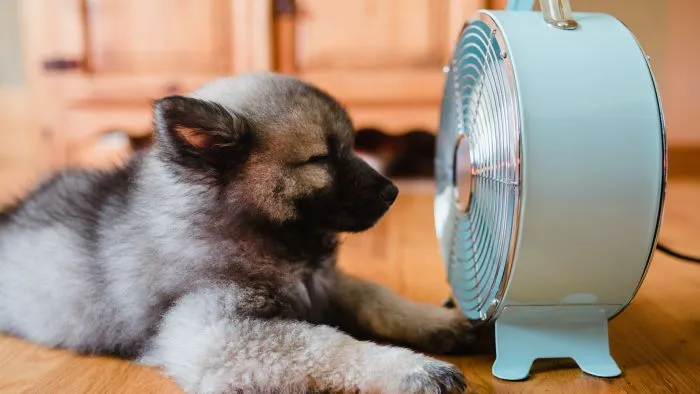Summer holidays bring a lot of fun activities to enjoy with your furry companion. You get to play numerous games in the backyard until you break out in a sweat and your paw friend starts panting. After a tiring session in the outdoors, have you ever wondered — Do dogs sweat?
You must have seen your dog panting on hot summer days, but apart from that, is there any other way for dogs to release their body heat? Like humans, do they regulate the temperature by releasing sweat? Yes, dogs too sweat but indeed differently from us. Let’s explore it in detail!

Do Dogs Sweat?
Yes, dogs do sweat. Just like humans dog too have sweating glands and they too sweat. However the way of dog sweating is quite different from the humans. Dogs have merocrine and apocrine as a sweating gland.
The merocrine sweat gland in dogs is located in their paws and it helps them to release the heat through the feet making them cool down.
However the apocrine sweat gland is located all over dog’s body. The other ways through which the dog releases the heat is through panting.
How Do Dogs Sweat?
Dogs too have sweat glands similar to humans. However, the function and characteristics of these glands completely differ. Dogs have sweat glands all over their body, but they release sweat only through certain parts of their body.
Dogs have two types of sweat glands:
One is the merocrine glands, which work just like human sweat glands and are mostly found in the paws, like those paws adorned with a dog raincoat with legs for those unexpected summer rain showers. These glands activate to cool them down when your dog feels hot. This is the reason you might see your dog leaving behind paw prints while walking on a hot summer day. These glands especially rest on the paws as it is the only hairless part of a dog.
The other one is the Apocrine glands, which are present all over the dog’s body. Its main purpose is not to cool down the body. It releases pheromones using which they identify other dogs by their scent.

Humans have sweat glands all over the body because the sweat easily evaporates in the form of heat. However, in the case of dogs, who are all covered with fur, it is difficult to evaporate the sweat. That’s why dogs have sweat glands in their paw pads, where there is less fur, allowing for more efficient cooling.
How Dogs Keep Themselves Cool?
Sweating plays a very small role in the cooling process for a dog. It is not possible to release all of their body heat through those tiny little paws. Thus, there are other ways through which dogs keep themselves cool.
Panting
While panting, air passes over the moist tissues of the tongue and nasal passage. Due to this, the moisture evaporates from the targeted tissues and cools them down. Panting is the most effective way for dogs to release their body heat and regulate their temperature.

Vasodilation
Vasodilation is another way a dog uses to control temperature regulation. It means the expansion of blood vessels. When they expand, warm blood moves closer to the surface of the body where it can be cooled.
The expansion usually takes place in the blood vessels of their ears and face. Due to this reason, their chin and ears are red when the temperature rises.
Does Fur Make Dogs Hot?
While your dog’s fur protects him in freezing winters, you might think that it would irritate the dog with more warmth in the summers. You might also have thought of shaving it down. But, just keep that as a thought because the fur helps the dog in summer to insulate the heat. Fur slows the transfer of heat from the hot environment to the body.[1]
The coat acts as an extra layer to maintain the body temperature and ensures thermoregulation. Shaving a dog can have detrimental effects on the dog during the hot days as they won’t have a layer of insulation.
Heatstroke in Dogs
When the temperature increases and the dog overheats, he is at risk of heatstroke, also known as hyperthermia. If a pet’s body temperature exceeds 103°F (39.4°C), it is considered abnormal. Body temperatures above 106°F can lead to multiple organ failure and eventually death.
“The most common cause of heat stroke or hyperthermia is leaving a dog in a car with inadequate ventilation. The dog’s body temperature in this situation can elevate very rapidly, often within minutes.“, confirms Krista Williams and Ernest Ward at VCA hospitals.
Some dogs are more prone to heatstroke, like very old or young dogs. If left untreated for too long, it can be fatal. Signs and symptoms of heatstroke should be identified and the dog should be immediately shifted to a veterinarian.

Signs of heatstroke include:
- elevated breathing rates
- dry or sticky gums
- abnormal gum colour
- bruising in the gums
- lethargic or disoriented appearance
- seizures
- excessive panting
- vomiting
Signs of heatstroke should be identified, and the dog should be immediately shifted to a veterinarian. On the other end of the spectrum, dog owners may wonder what temperature is too cold for dogs.
According to Veronica Higgs at petMD, “Heatstroke can occur very quickly and result in death in under an hour, especially if the pet does not have access to shade, water, and rest. This is an absolute emergency, and pet parents should take their dog immediately to the local emergency veterinary hospital if they suspect heatstroke. “
Heatstroke is an immediate medical emergency. Offer your dog cool water to drink. It may be poured over the head, stomach and feet, or cool cloths may be applied to these areas.[2] If using cool wet cloths, these should be continually replaced. Ensure a continuous flow of air across the dog to help increase evaporative heat loss.
FAQs
Can dogs sweat through their skin?
Unlike humans, who can sweat through their skin, dogs rely on only their paw pads to release sweat. Additionally, a dog’s paws do not produce much sweat, so this is not the ideal way for a dog to keep itself cool when it’s hot outside. There are other methods through which dogs release their heat.
How do dogs cool themselves?
Dogs cannot sweat through their skin because of an extra layer of coat. They release heat through their paw pads to regulate their body temperature. Apart from that, they rely on panting and vasodilation. If they cannot cool down, they will quickly develop heatstroke.
Does wetting a dog cool it down?
Wetting your dog’s coat can help to lower their body temperature. This is especially useful for dogs suffering from heatstroke. You can pour cool water on the head and stomach of your dog or put him in a bathtub to cool him down.
Wrapping Up
In a nutshell, dogs do sweat like humans but their functions and characteristics differ from that of us. They don’t sweat from every part of their body. Also, they have different functioning through which body temperature is regulated and surprisingly, their fur too plays a vital role in this.
While dogs sweat differently than humans, their coats play an important role in insulation. This raises the question – do dogs need coats or is their natural fur enough
However, if you ever feel your dog’s body temperature abnormal or other signs of heatstroke, consult a vet immediately for treatment. Hope this article helped you answer — Do dogs sweat?
References:
- Heat wave approaching! Should you shave your pet? (2017, July 14). ASPCA.
- Heatstroke: A medical emergency. (2022, December 2). Cornell University College of Veterinary Medicine.



